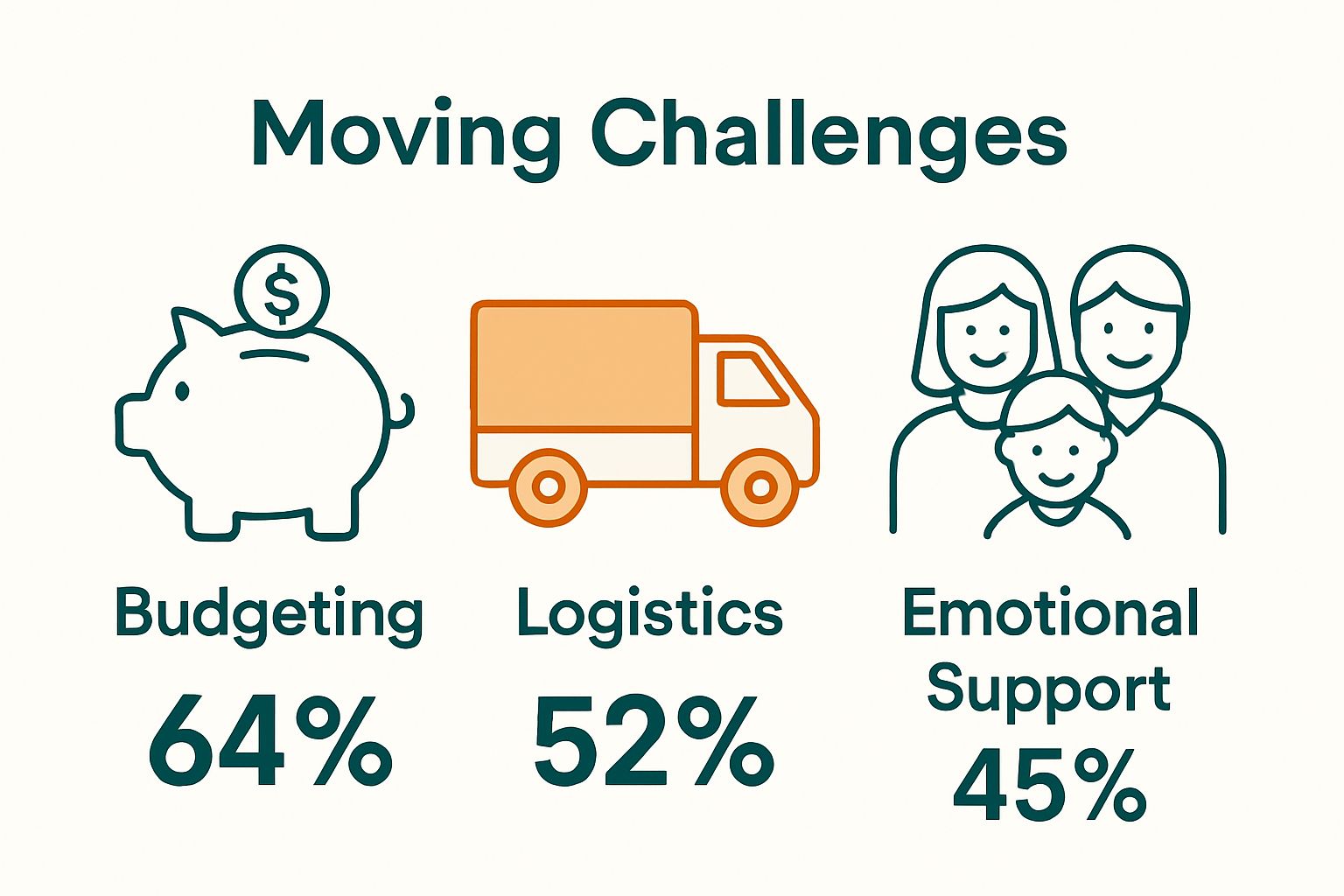Moving as a family feels complicated and overwhelming for a reason. Nearly 40 percent of all moves involve families with children, meaning hundreds of thousands juggle emotional, financial, and logistical chaos every year. Most people think the stress comes from packing up boxes or hiring movers. Actually, the biggest factor that shapes whether your move is smooth or full of headaches is something much less obvious and far more powerful: the way you plan before you even start.
Table of Contents
- Understanding The Importance Of Planning In Family Moves
- The Emotional Impact Of Moving On Families
- Key Logistics To Consider During A Family Move
- How To Maintain Family Routines During A Move
- Resources And Support Systems For Families In Transition
Quick Summary
| Takeaway | Explanation |
|---|---|
| Effective planning is essential for smooth moves. | A well-structured plan minimizes stress and ensures all family members are considered during the transition. |
| Emotional preparation is critical for each family member. | Recognizing and supporting emotional needs improves family resilience and eases the moving process. |
| Maintain family routines to reduce stress. | Preserving familiar activities helps provide stability, especially for children during the transition. |
| Leverage support systems for a successful move. | Utilize resources like moving consultants and community groups to ease the relocation process. |
| Communication among family members is vital. | Open discussions foster understanding, encourage shared responsibility, and strengthen family bonds during the move. |
Understanding the Importance of Planning in Family Moves
Moving as a family represents far more than simply relocating possessions from one place to another. It involves coordinating complex emotional, logistical, and strategic considerations that demand meticulous planning and thoughtful preparation. Understanding the significance of comprehensive planning can transform what could be a stressful experience into a manageable and potentially exciting transition.
The Strategic Framework of Family Moving
At its core, family moving requires a holistic approach that considers multiple interconnected elements. Successful moves are not spontaneous events but carefully orchestrated processes that demand advanced preparation. Families must recognize that effective planning serves as the foundational blueprint for a smooth transition. This involves synchronizing individual family members’ needs, managing practical logistics, and maintaining emotional stability throughout the moving process.
Key Considerations in Family Move Planning
Effective family move planning encompasses several critical dimensions that extend beyond basic transportation of belongings. Families should prioritize comprehensive strategies that address multiple aspects of relocation:
- Emotional Preparation: Acknowledge and support each family member’s emotional journey during the transition
- Financial Budgeting: Create a detailed financial plan accounting for moving expenses, potential interim costs, and unexpected challenges
- Logistical Coordination: Develop a systematic approach to packing, transportation, and settling into the new environment
According to Moving and Storage Association, approximately 40% of all moves involve families with children, underscoring the complexity of coordinating relocations across multiple age groups and individual needs.

Proactive Planning Strategies
Proactive families approach moving as a collaborative project.
This means holding family meetings, assigning age-appropriate responsibilities, and maintaining transparent communication. Our comprehensive moving guide offers additional insights into creating a structured moving plan that minimizes stress and maximizes efficiency.
By treating moving as a strategic process rather than a sudden disruption, families can transform a potentially overwhelming experience into an opportunity for growth, learning, and collective problem solving. The key lies in comprehensive preparation, mutual support, and a flexible mindset that embraces change as a natural part of family life.
The Emotional Impact of Moving on Families
Moving represents more than a physical transition of geographical location. It is a profound emotional journey that impacts each family member differently, creating a complex psychological landscape of anticipation, anxiety, excitement, and potential grief. Understanding the emotional dynamics of moving can help families navigate this significant life transition more effectively.
Psychological Dimensions of Family Relocation
Family moves trigger a multilayered emotional response that varies based on individual personality, age, attachment to current environment, and personal resilience. Children often experience the most intense emotional reactions, as their sense of security is closely tied to familiar surroundings, established social networks, and predictable routines. Parents, while managing logistical challenges, must simultaneously support their children’s emotional adaptation and process their own complex feelings about the transition.
To help readers quickly compare how the moving process affects different family members, the table below outlines the key emotional challenges faced by each group during a move.
| Family Member | Main Emotional Challenges |
|---|---|
| Children | Sense of loss, anxiety about making new friends, disruption of established social connections |
| Teenagers | Concerns about social status, romantic relationships, and educational continuity |
| Parents | Managing family stress, professional transitions, maintaining family cohesion |
Emotional Challenges Across Family Members
Each family member encounters unique emotional challenges during relocation:
- Children: Experience potential sense of loss, anxiety about making new friends, disruption of established social connections
- Teenagers: Often feel most dramatically impacted, with concerns about social status, romantic relationships, and educational continuity
- Parents: Navigate emotional management of family stress, professional transitions, and maintaining family cohesion
According to the American Psychological Association, moving can significantly increase stress and anxiety levels for both parents and children, with potential long-term psychological implications if not managed compassionately.
Strategies for Emotional Resilience
Successful emotional navigation during family moves requires intentional strategies that prioritize communication, validation, and collective adaptation. Families must create safe spaces for expressing fears, acknowledging losses, and celebrating potential opportunities. This involves holding regular family discussions, allowing each member to voice concerns, and developing collaborative coping mechanisms.
By recognizing moving as an emotional journey rather than merely a logistical challenge, families can transform potential stress into an opportunity for growth, strengthened familial bonds, and collective resilience. The key lies in empathy, open communication, and a shared commitment to supporting one another through significant life transitions.
Key Logistics to Consider During a Family Move
Successful family moves require far more than simply transporting belongings from one location to another. They demand intricate logistical planning that considers multiple complex variables simultaneously. Understanding and anticipating these logistical challenges can dramatically reduce stress and improve overall moving experiences.
Comprehensive Moving Infrastructure
Logistical planning for family moves encompasses a multifaceted approach that integrates transportation, timing, resource allocation, and personal considerations. Families must develop a holistic strategy that accounts for each member’s unique needs while maintaining an efficient overall transition plan.
The following table summarizes critical logistical considerations families must address to ensure a smooth move, highlighting each component and its main focus.
| Logistical Component | Main Focus |
|---|---|
| Transportation Coordination | Choosing vehicles, planning routes, managing cargo loading |
| Resource Management | Allocating finances, securing packing materials, budgeting for extras |
| Timing and Scheduling | Aligning move dates with work, school, and personal commitments |
Critical Logistical Considerations
Moving logistics involve several interconnected components that demand meticulous attention:
- Transportation Coordination: Selecting appropriate moving vehicles, determining optimal transportation routes, and managing cargo loading
- Resource Management: Allocating financial resources, identifying necessary packing materials, and budgeting for potential unexpected expenses
- Timing and Scheduling: Synchronizing move dates with work, school, and personal commitments
Research from the American Moving and Storage Association indicates that families who develop comprehensive logistical plans are 60% more likely to experience smooth, stress-reduced moving experiences.
Strategic Preparation Approaches
Successful logistical planning requires a proactive and flexible mindset. Families should create detailed inventories, establish clear communication protocols, and develop contingency plans for potential disruptions. Our portable storage solutions offer strategic options for families seeking adaptable moving approaches.
Ultimately, effective logistical management transforms moving from a potentially chaotic experience into a structured, manageable transition. By treating the move as a collaborative family project and maintaining open communication, families can navigate complex logistical challenges with confidence and minimal disruption.
How to Maintain Family Routines During a Move
Moving can disrupt the delicate rhythm of family life, challenging established patterns and creating potential emotional turbulence. Maintaining consistent routines during transitions becomes a critical strategy for preserving family stability and emotional well-being. By intentionally protecting familiar structures, families can navigate relocation with greater resilience and minimal psychological strain.
The Psychological Importance of Routine Preservation
Routines serve as psychological anchors that provide predictability, security, and a sense of normalcy during significant life changes. For children especially, consistent patterns offer emotional comfort and a feeling of control amidst the uncertainty of moving. Parents play a crucial role in strategically maintaining these routines, demonstrating adaptability while simultaneously providing a sense of continuity and stability.
Strategic Routine Maintenance Techniques
Effective routine preservation requires deliberate and thoughtful approaches that accommodate the unique challenges of moving:
- Meal Time Consistency: Maintain regular family meal schedules, even if dining locations temporarily change
- Sleep Schedules: Preserve bedtime rituals and sleep routines to minimize disruption
- Communication Patterns: Continue family meetings, check-ins, and shared activity times
According to the American Psychological Association, maintaining family rituals during transitions can significantly reduce children’s stress and emotional uncertainty.
Adaptive Routine Management
Successful routine maintenance demands flexibility and creative problem solving. Families should view routines as adaptable frameworks rather than rigid structures. Our decluttering guide offers insights into creating organized spaces that support consistent family rhythms during moves.
Ultimately, protecting family routines transforms moving from a potentially disruptive experience into an opportunity for demonstrating collective resilience. By prioritizing emotional continuity and maintaining key family traditions, families can navigate geographical transitions with grace, mutual support, and a strengthened sense of connection.

Resources and Support Systems for Families in Transition
Navigating family moves requires more than individual effort. Successful transitions depend on comprehensive support systems that provide practical assistance, emotional guidance, and strategic resources. Understanding and accessing these support networks can dramatically transform the moving experience from overwhelming to manageable.
Comprehensive Support Network Architecture
Effective support systems for families in transition operate through interconnected resources that address multiple dimensions of relocation challenges. These networks include professional services, community organizations, digital platforms, and informal social connections. The goal is creating a holistic ecosystem that provides comprehensive assistance tailored to unique family dynamics and specific moving circumstances.
Key Support Resource Categories
Families can leverage multiple support channels during transitions:
- Professional Moving Consultants: Experts who provide strategic planning and logistical guidance
- Community Support Groups: Local networks offering emotional support and practical advice
- Digital Resource Platforms: Online tools providing checklists, planning templates, and connection services
According to Military OneSource, specialized transition support can reduce family stress by up to 45% during relocation processes.
Accessing and Maximizing Support Resources
Proactive engagement with support systems is crucial for smooth transitions. Families should actively research, connect, and integrate available resources into their moving strategy. Our comprehensive moving apartment checklist provides additional insights into navigating support networks effectively.
Ultimately, robust support systems transform moving from an isolated challenge into a collaborative journey. By recognizing that transition is a shared experience, families can access diverse resources that provide practical assistance, emotional validation, and strategic guidance throughout their relocation process.
Simplify Your Family Move With Local Expertise
Managing a family move involves more than just packing boxes. As discussed, coordinating schedules, handling emotional stress, and maintaining daily routines can easily become overwhelming. Families are often searching for trustworthy, local support that genuinely understands the unique needs of moving with children and loved ones.
At STOMO, we recognize the importance of personalized planning and emotional support. Our Moving Service solutions are designed for families who need flexibility, transparency, and a stress-free experience. With flat-rate pricing and weather-resistant mobile containers, you can self-pack at your own pace or let our concierge team move you in and out efficiently.

Ready to make your next family move as smooth as possible? Let our local expertise provide the tailored support and reliable storage you deserve. Learn more or book your move now through https://stomostorage.com and see why South Carolina families choose STOMO for award-winning service. Discover how you can maintain your routines and ease your transition by exploring our full range of storage solutions today.
Frequently Asked Questions
What are some effective moving tips for families?
To ensure a smooth family move, prioritize detailed planning, adequate emotional support, and effective collaboration among family members. Start by holding family meetings to assign responsibilities and create a checklist of tasks to tackle over the next 30–60 days.
How can families manage emotional challenges during a move?
Acknowledge each family member’s feelings and provide a safe space for open communication about the move. Schedule regular family check-ins to discuss concerns and celebrate milestones throughout the transition.
What logistical aspects should families consider when planning a move?
Focus on transportation logistics, scheduling, and resource management to facilitate a smooth move. Develop a timeline and inventory list, and ensure all packing materials are ready at least a week before moving day.
How can families maintain their routines during a relocation?
To preserve routines, keep meal times, sleep schedules, and family activities as consistent as possible during the move. Aim to maintain these activities regularly, even if the locations change temporarily, to provide stability for children.
What resources are available to support families during a moving transition?
Families can benefit from a variety of support resources, including professional moving consultants, community support groups, and online planning tools. Actively seek out these resources and integrate them into your moving strategy for a smoother experience.
How can communication improve the moving process for families?
Enhancing communication among family members can alleviate stress and foster collaboration during the move. Schedule daily or weekly family meetings to update everyone on tasks, address concerns, and celebrate progress to build a sense of unity.
